
A beautifully illuminated manuscript in the National Library of Brazil, Rio de Janeiro
Tomorrow will we remember history?
Libraries, to me, are intriguing and exciting; the smell of books (yup, there is nothing like the smell of a newly published book, and no matter what anyone says, I am certain that most people who enjoy books will have at one time or another simply riffled through a new book and enjoyed the smell…), even old books several centuries old, is unique, and adds to the mystery of what might be found within their pages. I have had the good fortune of being able to visit several large libraries in different countries, and on each occasion the three or four hours I spent inside were simply not enough (I will easily spend two or three hours in bookstores, so I suppose several days would be more suitable for libraries).
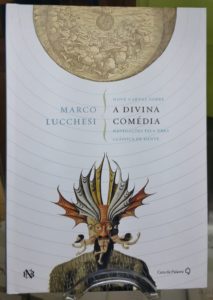
A master study of Dante’s Divine Comedy by scholar ; as happenstance would have it, a study of the exact book that I was lugging around with me in South America.
With modern technology, however, I am finding that I am spending less and less time actually reading books, and instead am glued more and more to a screen very much against my better judgment or want. Somehow a laptop just doesn’t seem to suit relaxed reading in a favourite chair, and sitting in a comfortable chair in a library reading from a laptop just seems sacrilegious. I have started taking steps toward changing my behaviour, and am not giving up internet and ‘app’ access at least one weekend per month – try it, it really is glorious. But I am talking about books and libraries, and in particular, the national library in Rio de Janeiro. It took me a short while to find my way back to the National Library in Rio, but as luck would have it, the library had put on an exhibition of some of its oldest materials, including manuscripts and books brought from Europe in the 14th and 15th centuries; I was in my element, and already foresaw that the day was not going to be long enough for me to enjoy all the displays of the “Cabinet of Curiosities” exhibition.
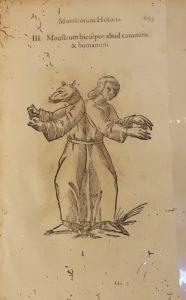
Of beasts and men, From “Monstrorum Historia” by Ulisse Aldrovandi
The world’s 7th largest library: Brazil’s National Library
The Biblioteca Nacional do Brasil is the largest library in South America, and the world’s 7th largest library. Housing around 9 million items, I figured that I would likely need more than a lifetime to be able to see every single item, so I settled for wandering around the five floors in the central core of the library which held the various cases displaying some of the weird and wonderful items held by the library. Instead of writing about the items, these pictures will give a better representation. As I wandered around the third floor, there was a small sign that pointed in the direction of a separate room, and unlike some of the other rooms off the central hallway, the doors to this annex were unlocked – here was a carefully curated exhibition of various works of ‘erotica’ over several centuries, hence the closed doors. Other items on display on the different floors included manuscripts – I went so far as to inquire how I might be able to spend some time actually studying them, and was told I would have to get a letter of introduction from my institution/university affiliation and put in an official request; since I had only that day remaining on my trip, that was not a possibility, but it is certainly something to be considered for a follow-up visit in the future. Taking one last glance at a magnificent map in a glass display cabinet I turned my feet in the direction of the exit and made my way down the stairs. Leaving behind the objects of the past, I made my way to a vision of the future; the Museum of Tomorrow.
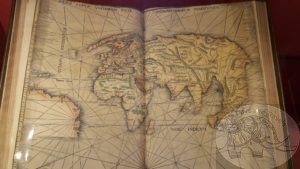 The world – as it was known in the 1600s
|
 Of heaven and earth, a scientific and astrological view of the universe. |
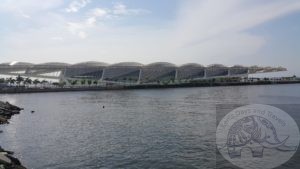
Museum of Tomorrow, Rio de Janeiro, Brazil
Our past, our future, will we have a ‘tomorrow’?
Situated on the shore of Rio’s harbour, the museum is not a repository of old and ancient artifacts, instead it is a place that asks questions, a place that “was born in the Praça Mauá as a science museum meant to explore, imagine, and conceive all the possibilities for constructing the future” (about Amanha). The exterior of the museum is modern in design, and sets the right tone for what is to be found inside.
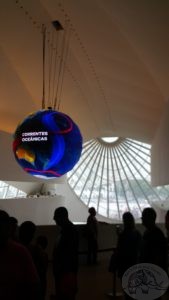
The world, our home; a presentation about our planet and how we are affecting its chance of survival.
A large globe suspended from the ceiling in the main reception hall displays messages about the geography, climate, geology, and human activities of and on the world. There is a small area outside the main entrance to the first exhibition space; an area which many people skip, but which holds a few important displays about the ideas and philosophies behind the establishment of the museum.
| “The amount of change likely to occur over the next 50 years will be greater than that of the past 10,000 years.” |
Once inside the main exhibition space, visitors are met by large walls displaying various multimedia presentations; a large dome in which the story of the cosmos is projected with 360 degree technology, is the starting point of the story. This is followed by presentations about our globe, Earth, matter, life, and mind. The third major exhibition space deals with our place in the story, our lives, our interactions, our effect on the world in which we live; as the write-up notes, “Studies show the world’s population will reach 10 billion by the year 2060. The amount of change likely to occur over the next 50 years will be greater than that of the past 10,000 years.” It is a sobering thought that we have had and will continue to have such devastating effects on the place we call home as we continue to gambol our way through the non-renewable resources at the pace we are devouring them now.
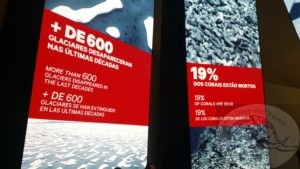
Some statistics – sobering
The fourth section of the museum speaks of ‘tomorrow’, and presents different possibilities for our future; “The exhibit explores the development and consequences of these trends through topics such as connected cities, energy production, genetic modification, bioethics, integration of technology and the human body, and the effects of climate change, migration, population density and social inequality, among others.”
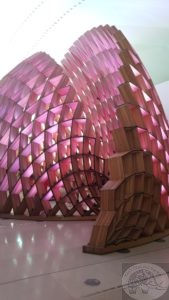
The Oca
The fifth and final part of the main exhibitions features a light and sound show in a structure that is said to resemble an ‘Oca’ or indigenous house of knowledge. This part of the exhibitions is called “Us” and I will leave you to read the description provided on the museum’s website, but when I saw the structure I thought it resembled more a protective shell, a space where visitors can spend a few moments to think about all that they have seen, all the knowledge they have gained; to reflect on our collective past, our present, and the vision of our future before leaving that small space of serenity and safety and returning to the present world and the daily toils and cares.
I spent a full day, moving from objects of the past at the library to the projections of the future; a day of learning and a day of reflection, and perhaps it was a most suitable way to spend my final day on this long journey through South America.
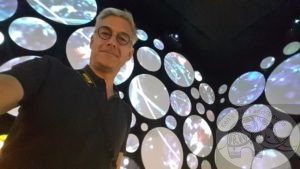
Visiting the “Museum of Tomorrow”
